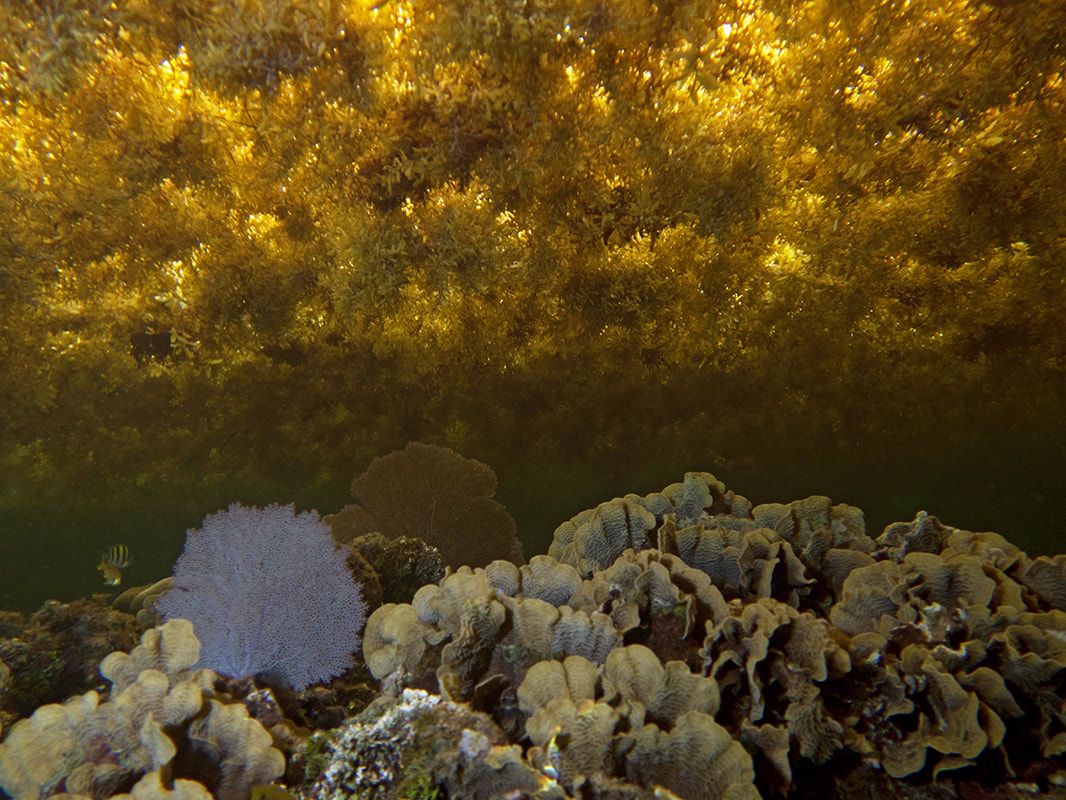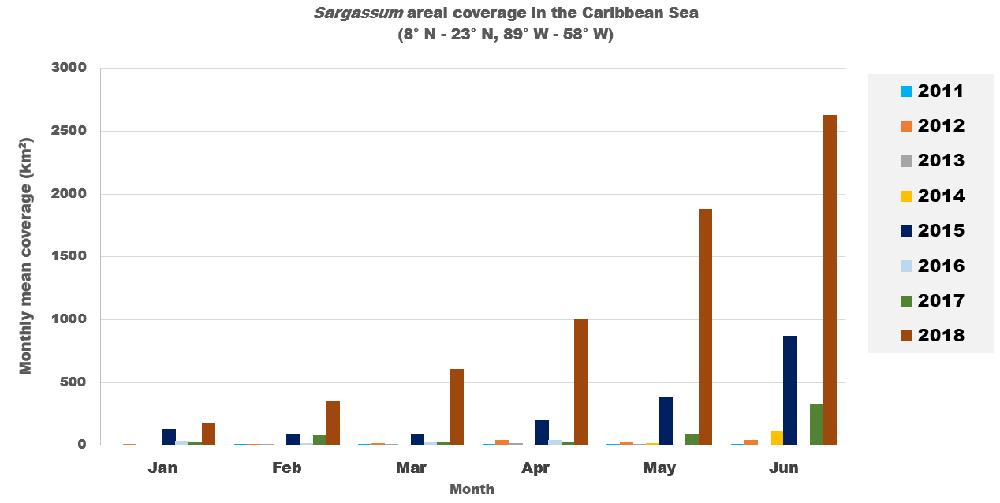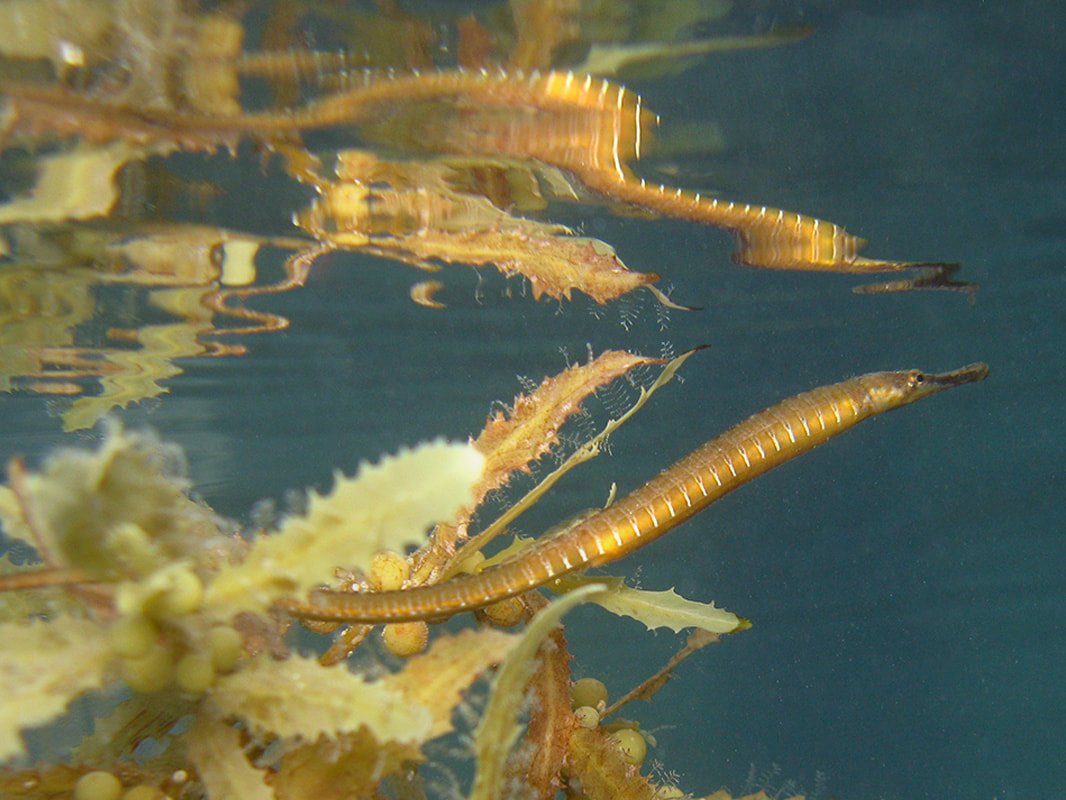Record-breaking amounts of sargassum in the Caribbean: What is it and where is it coming from?1/11/2019 2018 saw the largest sargassum bloom on record, 3 times the previous record. What is sargassum? Sargassum is a unique group of marine plants, brown algae that are kept afloat using small air-filled floats attached to the stalks. Not all sargassum species float on the surface, some remain attached to the reef and the tiny floats help the plant stay closer to the sunlight. The two main floating species are Sargassum natans and Sargassum fluitans. It reproduces by fragmentation and the growing plants can come together to form huge floating mats of brown weed that drift through the Caribbean during the warm summer months. Much of it is blown ashore during our winter storms. In 2011 there was a massive bloom of these plants, and every year since there has been more sargassum than usual in the Caribbean. In the last year we have seen unprecedented amounts of sargassum throughout the region. What's in the Sargassum?
There is a remarkable amount of life that is found living nowhere else. These species have evolved to blend in with the leaves of sargassum, both for protection and as camouflage while they hunt. They will spend their entire lives floating in the brown weeds. The most remarkable resident is the Sargassumfish. This relative of the frogfish has fleshy appendages to help it blend in with the sargassum while it hunts by stealth, and large pectoral fins that allow it to slowly "crawl" through the leaves to find it's next meal. Where is it all coming from? Most sargassum used to originate in the Gulf of Mexico, and would be caught in the normal currents that would take it out into the North Atlantic in an area known as the Sargasso Sea, 700 miles wide and 2000 miles long. This sea is not bound by land, but by ocean currents that form a swirling gyre, keeping the sargassum together. Christopher Columbus apparently thought he had found land when he encountered it on his voyage in 1492. Today it is also a trap for oceanic pollution: there are an estimated 200,000 pieces of trash per square kilometer and it has now been dubbed the "North Atlantic Garbage Patch." But what about the recent sargassum blooms in the Caribbean? After the 2011 bloom, scientists at the University of South Florida Optical Oceanography Laboratory found that this new sargassum had broader leaves than the usual varieties, and have been trying to trace it back to it's source using satelite imagery. For the record-breaking 2018 sargassum bloom they found it was coming from the south, as far away as Brazil, an area that had never before seen such large amounts of sargassum. Research is being done to see if this new strain entering the Caribbean actually represents a new species of sargassum. Fed by warm waters and possibly also the agricultural run-off from the Amazon delta, this new patch of sargassum is taken up by the regular ocean currents that enter the Caribbean from the east. What it means for the Caribbean: Sargassum is a natural, even essential, part of the Caribbean's ecosystems but these recent blooms are having a devastating impact on the region, both ecologically and economically. Many tourist areas and islands were innundated this year. It piles up on beaches, sometimes many feet thick and begins to decay. The hydrogen sulphide that gets released smells like rotting eggs and many resorts had to close their doors. Hydrogen sulphide is dangerous to humans in large quantities, causing headaches, dizziness, nausea and even asthma has been reported in some local communities. It is also extremely corrosive to metals and concrete.
It's not just the tourist industry that will be affected but also the underwater ecosystems that tourism depends upon. The decaying sargassum reduces oxygen levels in the water, causing stress or even death for nearby corals, sponges and fishes. The exact causes of these blooms in the Caribbean are still poorly understood and may involve higher sea temperatures and shifting currents. According to leading researcher Brian LaPointe of Florida Atlantic University: “Our research has found that nitrogen and phosphorus from land-based runoff and pollutants, including nitrogen-heavy fertilizers and sewage waste, are washing into rivers such as the Mississippi and the Amazon. This fuels sargassum growth.”
Whatever the cause, it appears that sargassum blooms are likely to become a common, even annual, event and those of us who live in the Caribbean must be ready to deal with it. It's not going away. Mickey Charteris
24 Comments
1/12/2019 06:10:38 pm
Great article, helps explain a lot about this years multiple blooms here in Roatan.
Reply
Rob Crook
1/13/2019 07:34:44 pm
Who is responsible for cleaning it up. I do have some ideas on what might be done with it and it could even help in the long term.
Reply
M Hinkson
1/14/2019 07:54:08 pm
Cleaning it up?
Reply
Baudouin Delneste
1/14/2019 01:41:56 pm
The main origin of this sargassum bloom, no the only one, seems to be the desertification of the subsaharian area, increasing the transportation of desert dust made of phosphates and iron minerals. Check more in internet after viewing those videos
Reply
Sommer MKF
1/14/2019 02:14:10 pm
Changing ocean currents (Gulf Stream) are changingtoo
Reply
Anteneh Gashaw
1/15/2019 01:40:32 am
From what I understand Sargassum is a unique group of marine plants, brown algae meaning it have some sort of nutrent to living animal if eaten. By training a behavioural change to "some fish species" or finding a creature who might be dependent on the algea we can eradicate it before it turns to the problem.
Reply
Bill
1/16/2019 04:45:51 pm
Well good idea but it did not work for the freshwater hyacinth. They introduced the walking catfish to irradiate them. Then poison the catfish. The catfish were way more adaptable to the toxins then previously thought. They increased the toxicity. It started killing native fish. They stopped the genocide. Now walking catfish proliferate. Truly the answer is simple, storm water runoff contains fertilizers needs to be stopped by good engineering.
Reply
Anteneh Gashaw
1/16/2019 10:59:22 pm
Hi Bill, Thank you for the information. I am not suggesting to use catfish and I am on progress of publishing which species to use and I assure you that it will work. And you will find out soon. Stopping fertilizers is very very very hard thing to do and it is unlikely to happen. The real solution is innovating how to manage and handle with out impacting the profitability of the source.
Anteneh Gashaw
1/17/2019 01:58:43 am
Bill, I am waiting for the link of catfish solution, I haven't found a single recorded finding research conducted.
Anteneh Gashaw
1/15/2019 02:58:33 am
is it an open challenge with a prize or just for helping the nature? Either way, I was studying a similar problem occurred in my country that could help.
Reply
Bill
1/22/2019 03:00:09 pm
Anteneh, you won't find any information on the catfish/hyacinth. It was over 50 years ago and covered up as an aquarium fish released into the wild. I did not mean to insinuate that the two algae's are similar, just that introducing an alien predator into the environment is not a good way to eradicate an algae bloom or any overgrowth. If sheet flow is bringing pesticides and fertilizers to the sea, a well engineered detoxification pond/ditches and natural materials to filter the chemicals is the best way if short-life fertilizers and pesticides are not available. There is no inexpensive way to accomplish that task aside from terminating the use of the offenders.
Reply
Anteneh Gashaw
1/22/2019 10:43:26 pm
Thank you Bill, that explains a lot. I do not have much information on the algae vs the geographic location of the Caribbean as i like and I am on process of looking in to it.
Anteneh Gashaw
1/15/2019 10:41:24 pm
This project proposes new way to solve this problem. The best solution is a long term solution but the Caribbean economy depends upon tourism that it needs a quick solution other than cleaning up the algae on normal or standard method. Since the basic problem is for the algae float, pile up and decay: we will give it no time to pile and decay by using a device seen above. Since the algae have considerable volume and we have the advantage of the current, we use the green structure to direct Sargassum into the red blade. The green structure is stationary fixed with the ground depending on direction of the current of the shore. Then the blade will cut the Sargassum into pieces and store the Sargassum in the blue holding storage made up of a flexible hard net that can pass the water but not the algae. The storage will prevent the Sargassum from decaying. Then regularly we change the holding net.
Reply
Bill
1/23/2019 05:22:11 pm
Anteneh,
Reply
Anteneh Gashaw
1/23/2019 09:48:57 pm
Bill, 1/22/2019 08:19:33 am
Hi Mickey,
Reply
1/2/2021 10:12:40 pm
Dear Mickey,
Reply
2/4/2021 01:12:55 am
THIS IS IT! Our third solution for the sargasum problem of the Caribbean. This project is about building a mechanism that can bury the piled up sargassum under the shore waters.
Reply
M Hinkson
2/5/2021 09:05:07 am
...a machine to "bury the piled up sargassum under the shore waters" could be worse then the problem itself.
Reply
Anteneh Gashaw
2/5/2021 09:20:10 am
M Henkson, 2/8/2021 04:53:35 am
Dear all,
Reply
2/13/2021 06:14:46 am
Design modified for the project "Caribbean Sargassum Problem 4.0" after I received constructive feedback from site engineers and machine operators.
Reply
2/15/2021 11:21:52 pm
Caribbean Sargassum Problem 4.0 (https://hackaday.io/project/177583-caribbeans-sargassum-problem-40 ) made me launch new bicycle called "VALCYCLE" (Valentine cycle) which is a double connected bicycles for couples to be riding on the rail road when the rail is not used by the automation cleaner.
Reply
3/9/2021 07:06:51 am
My Caribbean Sargassum Problem 8.0 is launched!!! ACCORDING TO EXPERTS IN THE CARIBBEAN AND LATIN AMERICA THIS IS ONE OF MY BEST WORK IN SIMPLICITY AND INNOVATION....
Reply
Leave a Reply. |
AuthorMickey Charteris is an author/photographer living on Roatan. His book Caribbean Reef Life first came out in 2012 and is currrently into it's sixth printing as an expanded fourth edition. Archives
August 2019
Categories
All
|














 RSS Feed
RSS Feed